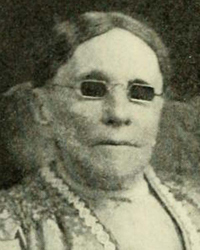History of Hymns: “Jesus, Keep Me Near the Cross”
"Jesus, Keep Me Near the Cross"
Fanny J. Crosby
The United Methodist Hymnal, No. 301
 |
|
Fanny J. Crosby |
Jesus, keep me near the Cross,
there a precious fountain,
free to all a healing stream,
flows from Calvary’s mountain.
In the Cross, in the Cross,
be my glory ever,
till my raptured soul shall find
rest beyond the river.
Fanny J. Crosby (1820-1915) was the author of over 8,500 gospel songs. Though blind at 6 weeks of age, Crosby began composing texts at age 6. She later became a teacher at the New York School for the Blind, where she was a student. A friend of several presidents, Crosby became one of the most important advocates for the cause of the blind in the United States.
Her texts were set to the compositions of some of the most prominent gospel song composers of the day including William Bradbury, William Doane and Ira Sankey. Crosby composed under a number of pen names. She married blind musician Alexander Van Alstyne. British hymnals identify her as Frances Van Alstyne, her married name.
This hymn first appeared in the collection Bright Jewels (1869), compiled by Bradbury, Doane, W.F. Sherwin and Chester G. Allen, at least two of whom were famous writers of gospel song tunes. Indeed, it was Doane who wrote the music and then gave it to Fanny Crosby to add the text—a practice that was not uncommon in their relationship.
UM Hymnal editor Carlton R. Young notes: “It is one of many texts by Crosby that combine vivid imagery (she was blinded in her childhood) and powerful biblical and evangelical metaphors: the Cross, a fountain of healing streams, free grace, the daily walk of faith, God’s pursuing love and mercy, Jesus, the Lamb of God, beyond the river of death—heaven with its golden streets—and rest for the post-Raptured souls.”
The glory of the Cross, a theme of the refrain, is a common metaphor of Romantic-era hymnody. The Cross, a place where the pain of earth and the joy of heaven come together, is a kind of spiritual altar to which we might draw near for refuge and solace. From it flows a “precious fountain”—an image perhaps borrowed from the 18th-century poet William Cowper and his hymn “There is a fountain filled with blood” (UM Hymnal, No. 622).
Though an instrument of cruel punishment and torture, the Cross is a source of a “healing stream” (stanza one) and a place where “the bright and morning star sheds its beams” on us (stanza two).
Stanza three invites us to meditate upon the Cross—“bring its scenes before me.” The “shadow” of the Cross falls on my daily path. This image is reminiscent of another Romantic-era poet, Elizabeth C. Clephane, who in 1872 wrote “Beneath the Cross of Jesus” (UM Hymnal, No. 297).
Many writers have commented on Fanny Crosby’s ability to employ the technique of hypotyposis—painting a vivid scene as if it were present—even though she was blinded soon after birth.
The famous evangelist Dwight L. Moody was said to have asked Crosby the following question toward the end of her life: “If you could have just one wish granted, what would it be?”
Moody expected her to ask for sight. Sensing this she is said to have replied, “If I could have one wish, I’d wish that I might continue blind the rest of my life.” Moody was taken back and asked, “How can you say that?” Crosby was said to have responded, “Because, after being blind for all these years, the first face I want to see now is the face of Jesus.”
The eschatological theme of “Near the Cross” captures the hope and joy of heaven that is so characteristic of Crosby’s hymns: “Till my raptured soul shall find rest beyond the river.”
Dr. Hawn is professor of sacred music at Perkins School of Theology, SMU.
Contact Us for Help
View staff by program area to ask for additional assistance.
